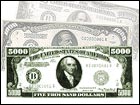
NEW YORK (CNN/Money) -
When is $1,000 worth more than $1,000?
Yes, it's a trick question. But there is one instance in which a grand can fetch, well, more than a grand -- and that's if you're selling a $1,000 bill. In fact, you may make substantially more than face value on the sale of a $500, $5,000 or $10,000 bill, too.
Most people have never seen one of these whopping-denomination bills, because the U.S. government had them removed from circulation in July of 1969. These notes are still legal tender, and it's not illegal to have one. But if you choose to deposit one at the bank, you only get face value for it, and your bank is supposed to turn it over to the Fed, where it's destroyed.
Don't worry. There's a better alternative: you can sell your big ol' bill for a handsome profit on the currency collectors' market.
The U.S. government first ordered these denominations in 1918, for bank-to-bank transactions, according to David Harper, editor of monthly newsletter Banknote Reporter. (There were no electronic clearing mechanisms at the time, and banks would often physically transport large quantities of cash to one another. Enter the large bill.)
So why would anyone have one of these bills lying around?
Many people kept their savings in large bills in safes and/or other safe havens after the Depression, because they no longer trusted banks with large sums of their money, Harper said.
"The hoarding aspect accounts for the high survival rate of these bills. People didn't trust banks during the 1930s, kept large bills in their safety-deposit boxes, and just left them there," Harper said. "Many have died, and now their heirs have [the bills]."
So go dig around in that wall safe. If William McKinley's staring at you from a bill, it's a $500. Grover Cleveland? One grand. James Madison? $5,000. Salmon P. Chase (antislavery activist, Secretary of the Treasury under Lincoln, and Chief Justice of the Supreme Court, but you already knew that) graces the $10,000.

The amount you'll make on the bill depends on its condition. According to the 2002 Standard Guide to Small Size U.S. Money, you'll get plenty if the bill is in "crisp, uncirculated" condition, meaning it's practically fresh off the printing press. A bill in "very fine" condition shows some use, but still has some crispness and what the book terms a "uniformly nice appearance." And a bill in "good" condition isn't crisp at all and might have a few stains -- it looks like an ordinary, used bill, from your wallet or a cash register.
"The more creases and wrinkles a note has, the less valuable it is. The more it looks like it's uncirculated, the more money you'll probably get," said Stephen Bobbitt, spokesperson for the American Numismatic Association.
Even if your mega-bill looks like it's been around the block a couple times, you're almost guaranteed to get more than face value. A typical price range on a 1928 $500 is between $750 and $1000, according to Bobbitt. For a 1928 $10,000, prices would start at about $20,000 to $30,000. For a 1928 grand, you could make between $1,400 and $1,600.
And if you've got a 1918 bill, you're in even more luck, according to Harper. Bill dimensions were changed with the 1928 series to today's size, but 1918 bills were larger, measuring about 7 3/8" by 3 1/8". That's part of the reason why they're more valuable. Prices for a 1918 $1,000, for example, would start at $1,750, Bobbitt said.
Only 5 of the 13 remaining 1918 $5,000 notes are accounted for. Two are at the Smithsonian Institution, one is at the Federal Reserve Bank of Chicago, another is at the San Francisco Fed, and one belongs to a private collector. As for the 10 outstanding 1918 $10,000 bills, nine are still at large -- only one is accounted for. It has been so long since a 1918 $5,000 or $10,000 bill has been sold that they both can be considered priceless.
| |
 Related Stories
Related Stories
| |
| | |
| | |
|
The one bill you won't find in Grandma's safety-deposit box is a $100,000 bill, although these notes were once issued for bank-to-bank transactions as well, Bobbitt said. About two dozen of the original 42,000 remain. Currently, only the U.S. Federal Reserve, the U.S. Department of the Treasury, and the American Numismatic Association have $100,000 notes.
Which president was lucky enough to land on the $100,000 note, you ask?
"That's always a 'Jeopardy' question," Bobbitt said. "Who is Woodrow Wilson?"

|

